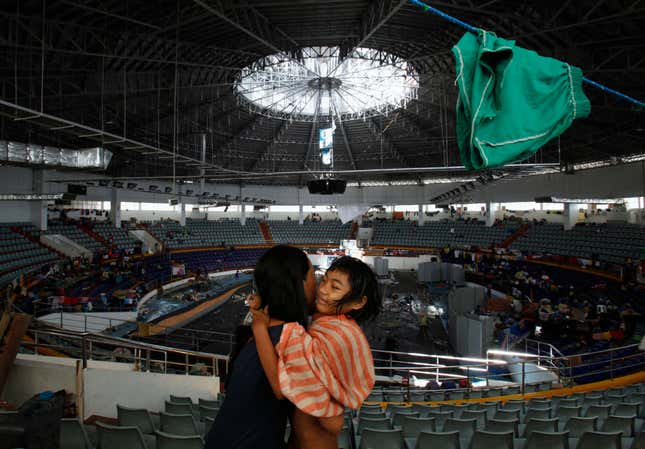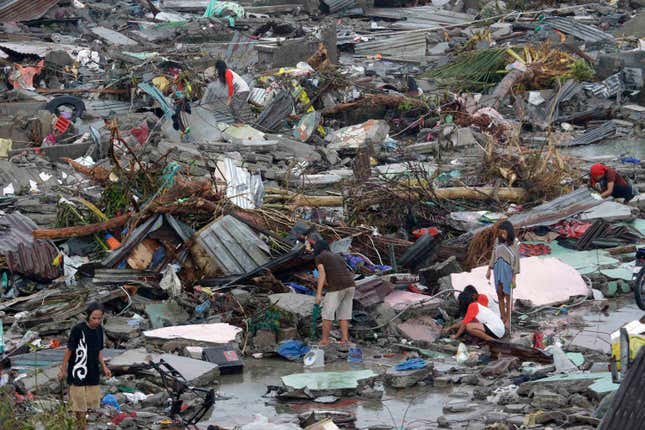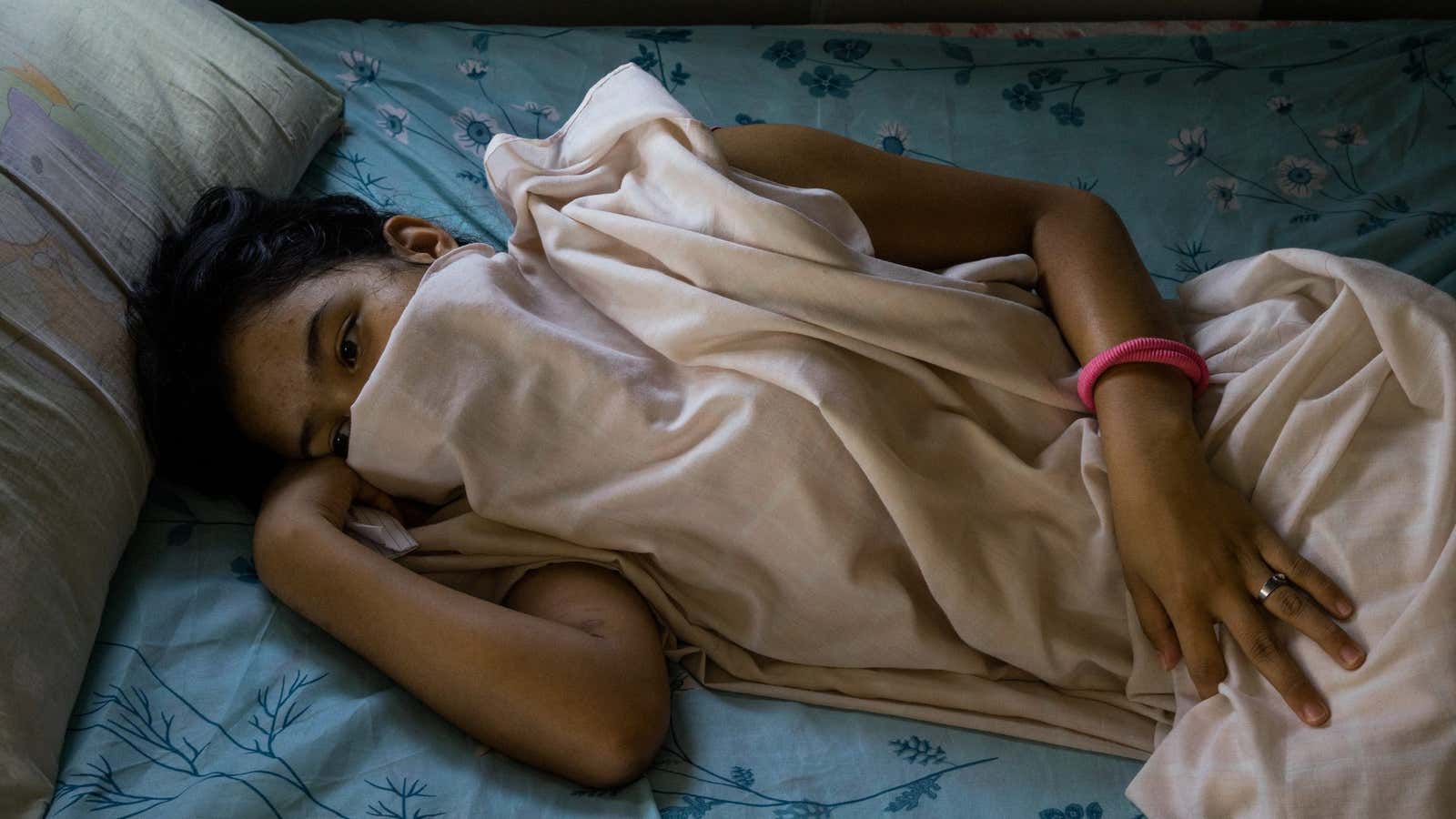When Typhoon Haiyan struck the Philippines in November 2013, it was, at the time, the strongest storm in history ever to make landfall. A “super typhoon” with wind speeds that reached 196 miles per hour, Haiyan displaced more than 4 million people and nearly wiped out the coastal city of Tacloban. Residents like Kristine still recall the smell of death that floated on the sea breeze and permeated streets.
“Too many people died,” Kristine says, somberly. But the storm, known locally as Yolanda, was just the beginning of the painful journey she was about to take.
After the skies cleared, a second humanitarian disaster unfolded in the Tacloban Astrodome, a sports arena where thousands took shelter. An underground economy took root as women and girls were sold for food and scarce aid supplies, or trafficked into forced labor and sex work by recruiters offering jobs and scholarships. Kristine says she was sold to men every night; some of the men were foreign-aid workers, she believes. The men raped her, and took graphic pictures and videos. Kristine was 13.

As severe storms and rising sea levels wear down coastal regions, women and girls are at ever-greater risk. Climate change is a new push factor for human trafficking; its effects destroy livelihoods and place women and children in post-catastrophe situations that traffickers exploit.
The Philippines is one of the countries most vulnerable to climate change, which scientists have linked to an increased frequency and severity of extreme-weather events like Haiyan. The country consistently ranks within the top five nations most prone to extreme weather and natural disasters. It’s getting worse; temperatures have been recorded at the highest levels in history in recent years, and five of the 10 deadliest storms to ever hit the country have taken place since 2006. The Eastern Visayas, of which Tacloban is the largest city, is often ground zero for the typhoons that make landfall in the Philippines.
The destination for many of those trafficked out of the Eastern Visayas is Angeles City, the sex-tourism capital of the Philippines about 600 miles to the north. Wendy, 25, who grew up in the Eastern Visayas, worked as a “bar girl” at Club Atlantis on Angeles’ notorious Fields Avenue—a red light district that sprouted to serve men stationed at Clark Air Base, an American base that operated from the early 1900s, when the Philippines was a US colony, until the mid-1990s. Today, Fields is a few blocks lined with bars, neon lights, and foreigners—mostly men from the US, Europe, and Australia—where girls dance on stages in bikinis or less. Customers can buy “ladies’ drinks” to spend time with the girls of their choice, or they can pay a “bar fine” to take a girl out for the night.

Wendy was already in Angeles when Haiyan hit and remembers a wave of people from the Visayas arriving to work on Fields shortly after the storm. “Fields Ave was like Tacloban, everyone was my town-mate,” she says. Her own cousins boarded a flight to Angeles with tickets they believed to be free, given as aid, but once they arrived they were recruited to work in bars.
“I was so worried because there’s nothing you can do to help them. You’re powerless,” says Wendy. “Why does this happen? It never stops—one tragedy after the other. After [Haiyan], there was Ruby.” Super Typhoon Ruby, known internationally as Hagupit, struck Tacloban just one year after Haiyan as residents were still recovering.
Nothing and everything to lose
“When you’re degrading the environment, you’re degrading the status of women,” says Emma Porio, a professor of sociology at Ateneo de Manila University.
When families lose their livelihoods and can’t recover between severe weather events, pressure increases on women and children to provide for the family—sometimes at any cost.
According to Porio, women are expected to care for and feed children—often becoming primary providers in the household in poor and rural communities in the Philippines. “The domestic space is her ‘queendom’ but it’s also the source of her oppression,” says Porio. The responsibility to provide for the family by any means necessary makes women more susceptible to traffickers’ misleading offers for employment, and less likely to leave an abusive employer after they have been trafficked.
Wendy is now in college in the Philippines, after being taken in by Renew Foundation, an NGO that counter-recruits bar girls and provides housing and other services. She and Nina say their stories are typical of many of the girls who work in Angeles City or who were trafficked into prostitution and domestic work as nannies and maids across the country.
Social workers with the Department of Social Welfare and Development in the Eastern Visayas reported an increase in the number of trafficked persons after Haiyan, more than tripling from 20 to 60 victims served in the region in the year after the storm. Still, they are largely unable to capture the magnitude of the problem.
The Philippines is among the countries with the highest estimates for trafficking in the world. But victims often go undocumented because they choose not to come forward or cannot escape. The Global Slavery Index, an internationally recognized estimate of the prevalence of modern slavery, calculates there to have been about 400,000 trafficked persons in the Philippines in 2016. But the Philippines’ Department of Social Welfare & Development, which provides assistance to trafficking victims in the country, identified only 1,465 victims in its annual report.
And for the most part, justice goes unserved for these victims. Of the hundreds of thousands of people estimated to be trafficked each year, there have only been 265 trafficking convictions since 2005.
Climate change only compounds this lack of reporting and intervention. During the worst storms, because of the breakdown of communication and public services, even limited existing efforts to seek justice and prevent trafficking are stymied. In Tacloban, for example, every open legal case was dropped after the city prosecutor’s office was overtaken by waves in Haiyan. Evidence, paper, and electronic files were all lost. The walls of the prosecutor’s office are still stained with watermarks and lined with shelves of warped casebooks. Tacloban did not get its first human trafficking conviction until this year.

But the barriers are not just institutional. For many women who were initially coerced into prostitution, the desire to send money back home, along with the stigma of having worked in the sex industry, keeps them from coming forward or seeking legal justice. Some women even return to their hometowns after a storm to recruit relatives to work alongside them in the bars and brothels.
“Just imagine yourself on day one after Haiyan. You see all the dead. You see everything damaged. What are you going to lose if someone tells you ‘I’m going to give you food or I’m going to support your studies’?” says Romina Sta. Clara, a “protection specialist” with the International Organization for Migration.
Home, Children, Storm
The solution lies in investing in women so they can lay the groundwork for more resilient communities. To date, says activist Antonia Loyzaga, the country’s disaster-relief efforts have focused on short-term emergency response in the short-term: providing food, shelter, and medical care to victims in the immediate aftermath of a storm like Haiyan. But these haven’t accounted for long-term problems like trafficking.
Loyzaga recently retired from her post as the executive director for the Manila Observatory, a meteorological research institute in the Philippines, to focus on promoting gender equity within the context of disaster recovery, adaptation, and resilience to climate change. Now she is advocating for an approach to disaster planning that incorporates efforts to uplift women and families so they are less vulnerable during a natural disaster.
“People have not yet recognized that to be resilient is to narrow the gaps across sectors,” says Loyzaga. Addressing disparities in resources, economic and political power, she says, will help women better cope with the threats posed by a warming planet.
Those who work on trafficking and migration say it’s becoming more and more clear that climate change increases the risk for violence against women. “We’re not just seeing this as a phenomenon in the Philippines. This is something that more and more countries in Asia and the Pacific will be affected by,” says Sta. Clara. “That’s the reality of climate change.” Traffickers have, for example, targeted children displaced by climate-change related floods throughout South Asia, particularly in India and Nepal. A report by the United Nations Environment Program noted that trafficking increased by 20-30% during natural disasters in Nepal between 1990 and 2011.
On Christmas Day 2016, another super typhoon, “Nock-ten,” slammed into the Philippines, sending about 380,000 Filipinos into evacuation centers where traffickers prey. Although nearly all of the displaced were able to return home by the end of January, some 395,000 buildings sustained damage and 195,000 metric tons of rice, corn, and high-value crops totaling $90 million were lost.

As thousands of families cope with the aftermath of these storms, national and global efforts to address climate change are in limbo.
US president Donald Trump has threatened to withhold $3 billion the Obama administration committed to the UN Green Climate Fund, established to help developing countries like the Philippines adapt to the effects of climate change. As the one-year anniversary of the signing of the landmark Paris Agreement on climate change approaches, it remains to be seen if Trump will follow through with his pledge to back out of the deal.
New Philippine president Rodrigo Duterte has flip-flopped on the issue. At first, he said climate efforts should take a backseat to industrialization in his country and refused to support the Paris deal. Then he signed the agreement in February, and it entered into force on Earth Day, April 22. Now, the Philippines is eligible to get funding through international climate finance mechanisms, and the country is allowed to participate in negotiations on how the world will reach the Paris goal of limiting global warming to 2°C above pre-industrial levels.
In the meantime, women on the frontlines of climate change are finding ways to keep each other safe.
Jenia Rosialda, 23, and her friend Eva Ybanez Ingo, 26, were among the lucky survivors of Typhoon Haiyan. The two took shelter in the Tacloban Astrodome, where they faced new dangers once the storm passed. “If we would doze off, we would be unaware—it was dangerous for us,” says Rosialda. “We have to make alliances so we can look after each other, woman to woman.” They were afraid of sexually assault in common wash areas, so they avoided bathing or urinating alone.
The two recall chaotic crowds in the shelter when aid was distributed. They say some men were able to push to the front and collect more goods than others. Some women, in dire need of basic necessities, resorted to exchanging sex for provisions. Rosialda and Ybanez instead relied on each other for daily needs. “Share your blessings,” was their motto, Rosialda says. “If I run out of panties, can you lend me some?”

After leaving the Tacloban Astrodome, 13-year-old Kristine was trafficked to Manila by a family friend. She worked as a domestic worker for little pay, and was sometimes locked in a room for days. With the help of a neighbor, she eventually escaped and is now living in a shelter operated by Visayan Forum, an NGO working against trafficking in the Philippines.
Now 16, Kristine plays a game at the shelter called “Bahay, Bata, Baguio” (“Home, Child, Storm”). To play, the young women stand in groups of three. Two girls raise their arms to build a roof above the third, who plays the “child.” When the facilitator calls out “storm,” chaos ensues as everyone disbands, runs around the room, and forms a new trio—building a new home with a new child underneath. The game is a symbol for these young women: whatever storms may come, every child deserves to find safe shelter.
* * *
“Kristine” and “Wendy’s” names have been changed because they are still housed in shelters for their safety. This story was reported with funding support from The GroundTruth Project, a media nonprofit focused on international enterprise journalism.
